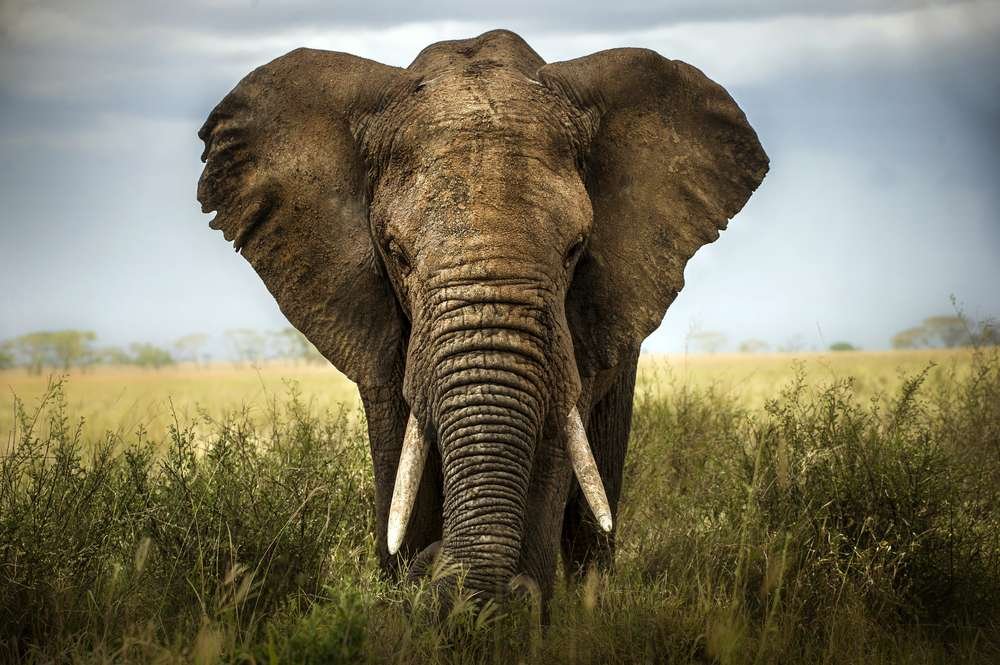African Elephant
( njovu or insofu )
- Loxodonta africana
- IUCN Status: Endangered
- Trend: decreasing
- Avg. Population: 3840

- Kingdom: Animalia
- Phylum: Chordata
- Class: Mammalia
- Order: Proboscidea
- Family: Elephantidae
- Subfamily: Elephantinae
- Genus: Loxodonta
Share:
General Information
The African Elephants are iconic giants. An elephant’s trunk has 150,000 muscles and is actually an extension of its upper lip and nose. At the end are two prehensile ‘finger like’ protrusions which are covered in fine, sensory hairs. It is so sensitive that it can pick up small leaves and fruit and so strong that they can use it to uproot trees. It is also used to smell, suck up water for drinking and for communicating.
Their large floppy ears help to keep them cool. In hot weather they increase the blood supply to the veins in their ears and flap them to cool their blood and their overall body temperature. They also use their ears to make themselves look bigger when they feel threatened.
They use their tusks for digging roots and for water, stripping bark from trees and as a weapon when fighting.
Elephants have a very good sense of hearing and smell, but poor eyesight
Fun Facts!
African Elephants are the largest land based animals in the world. They say “an Elephant never forgets” and though it might not entirely be true, it is clear that elephants have a very long memory. Another interesting trait is that Elephants mostly communicate using Infra-sound at about 15 Hertz, below the audible limit of human beings.
Description
- Shoulder height: 2.5 – 3.3 metres
- Length: 6 – 7.5 metres
- Weight: up to 6 tonnes
- Lifespan: 60 – 70 years
Ecology and Behaviour
They spend over 16 hours a day feeding on a variety of grasses, leaves, branches, roots, fruit and bark. An adult elephant requires 160 kilograms of food and can drink 200 litres of water a day. They have a poor digestive system, only absorbing about 44% of the food they eat.
Elephant’s snore! African elephants actually sleep for the shortest time of any mammal, on average sleeping for only two hours a night. They can sleep both standing up and lying down.
They use a combination of both vocal and non-verbal ways to communicate. Loud trumpeting may signify excitement, danger and aggression. They also squeal and emit low-frequency rumbling, which can be heard by other elephants 8 kms away. They are very tactile and will wrap trunks when they greet, lean against each other when feeding and mothers guide their calf by holding onto its tail.
Elephants cannot jump, but they are very good swimmers and they use their trunk as a snorkel. They enjoy mud wallowing and dust bathing which helps to cool down in hot weather.
Conservation
Elephants are listed as critically endangered on the IUCN Red List. Despite downward trends, the IUCN’s assessment highlighted the impact that conservation efforts are now playing, especially with anti-poaching measures together with land-use management strategies, which seeks to foster human-wildlife coexistence.
Distribution and Habitat
Elephants live in complex social family units, called herds. A herd consists of related females with their youngsters and is led by a dominate female, called a matriarch. Males live in smaller bachelor herds or are solitary.
Females give birth to one calf after a gestation period of 22 months. Their young will wean at about one to two years, but continuing suckling for three to four years. Young elephants are very dependent on their mothers and on the other females, or aunts, in their herd. They are very intelligent. Growing up in their herd they learn social and survival skills from the older females, such as what to eat and where to find good water sources. Females stay with their herd for life whilst males are ‘pushed out’ of the herd when they reach puberty at about 14 years of age.
They live in a wide variety of habitats, including savannah grasslands, woodlands, forests, swamps and floodplains. Elephants will travel long distances in search of food, water and shelter, walking 30 – 60 km a day. Although they have no natural enemies, young elephants are preyed upon by lion, leopard, hyena and crocodiles. When threatened they stand tall, raise their tusks and shake their heads. Then they may flee, mock charge or even fully charge an intruder. They are also very timid, running away from a bird or small animal that spooks them.
Interaction with humans
The main threat that humans have posed to elephants include habitat loss, human wildlife conflicts, climate change, poaching for their meat and the illegal trade in ivory.
No donation to this project yet.
| M | T | W | T | F | S | S |
|---|---|---|---|---|---|---|
| 1 | 2 | 3 | 4 | 5 | 6 | 7 |
| 8 | 9 | 10 | 11 | 12 | 13 | 14 |
| 15 | 16 | 17 | 18 | 19 | 20 | 21 |
| 22 | 23 | 24 | 25 | 26 | 27 | 28 |
| 29 | 30 | 31 | ||||


